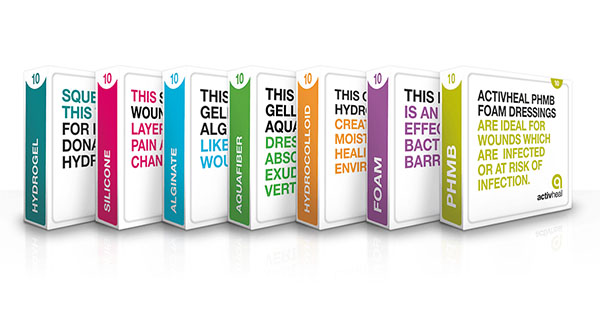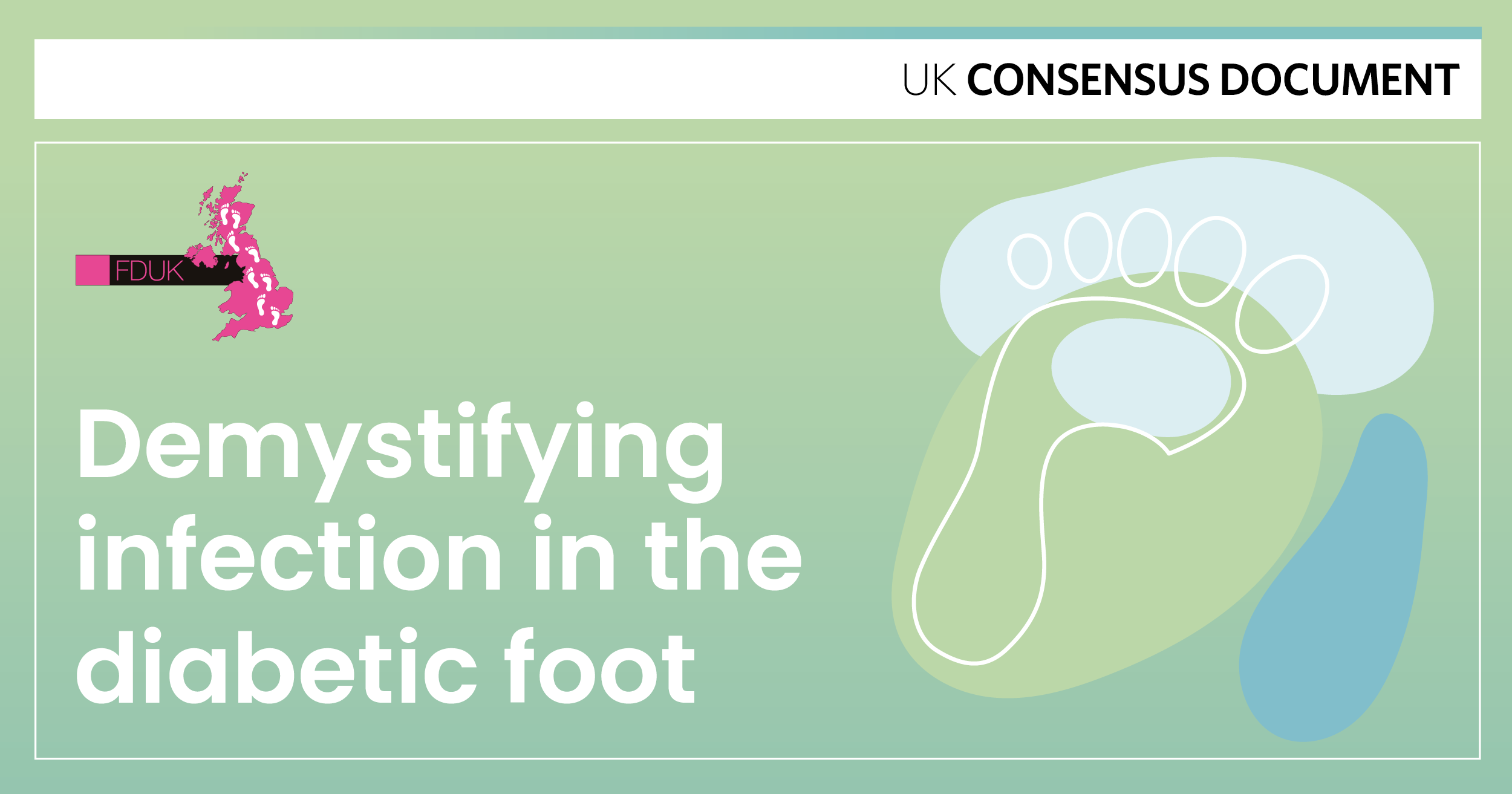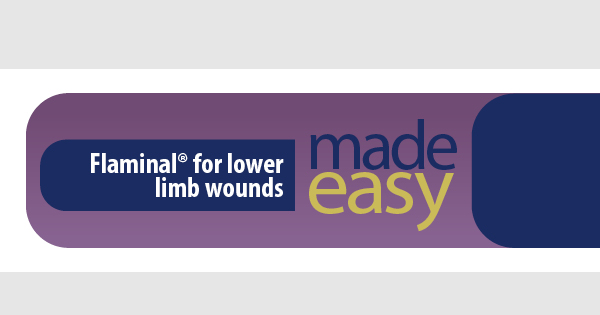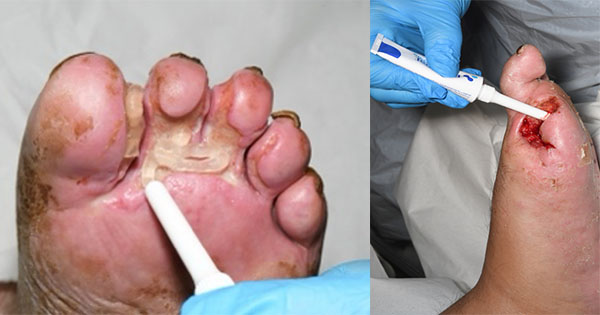There are significant challenges associated with treating both acute and chronic wounds and promoting wound healing. These include preventing and treating infection, managing wound exudate and improving the patient quality of life (QoL).
A wound compromises the skin barrier allowing the entry of a variety of microorganisms, which can lead to infection (International Wound Infection Institute [IWII], 2022). The presence of these microorganisms may result in delays in wound progression and healing (Swanson et al, 2022). Chronic or hard-to-heal wounds are susceptible to the development of biofilm, with over 70% having biofilm present (Malone et al, 2017).
It has been argued that infection is the most common and potentially preventable barrier to healing (Han and Ceilley, 2017), effecting all phases of the healing response (Wynn, 2021). A key aspect of this challenge is the production of bacterial toxins, which can exacerbate inflammation in the wound, negatively effect host cells, stimulate the production of protein-degrading enzymes that damage local tissue and increase the level of pain experienced by patients (Wynn, 2021).
Both acute and chronic wounds produce varying levels of wound exudate that plays a crucial role in wound healing. However, the presence of exudate can impede healing, especially if it is present in incorrect amounts—either too little or too much—if it comes into contact with the periwound area or if its composition contains high levels of tissue-degrading proteases (World Union of Wound Healing Societies [WUWHS], 2019). Wound dressings are the primary choice for managing exudate. Different dressings have different fluid handling capabilities (WUWHS, 2007). Foam dressings can absorb, and may also be able to retain fluid, under pressure (Fletcher, 2005), which is particularly important for protecting periwound skin from maceration and excoriation (WUWHS, 2019; Rippon et al, 2022).
Infection often leads to pain in wounds, with wound pain being the most common indicator of infection onset (Li et al, 2021). The prevalence of persistent, chronic wound-related pain has been reported to affect up to 80% of patients (Leren et al, 2020), and the stress associated with such pain has been shown to negatively impact wound progression (Matsuzaki and Upton, 2013).
Antimicrobial agents and combating infection in wounds
The use of antimicrobial wound dressings can reduce the risk of infection and address existing infections (Negut et al, 2018; Yousefian et al, 2023). Antimicrobial agents have gained recognition as the primary approach to managing bacterial burden (Daeschlein, 2013). However, there is concern about the use of topical antibiotics for treating infected wounds, due to the potential development of antibiotic resistance (Cooper and Kirketerp-Møller, 2018). World Health Organization (WHO, 2021) guideline recommends the use of antiseptics instead of antibiotics to help minimise the rise of antibiotic resistance, aligning with the principles of antimicrobial stewardship (AMS).
Antiseptics, such as silver and iodine, have demonstrated success in treating wound infections. Polyhexamethylene biguanide (PHMB), an antiseptic, has emerged as an additional option incorporated into various wound care products with different application modalities, such as solutions or gels (Rippon et al, 2023). PHMB is effective against a broad spectrum of microorganisms, including antibiotic-resistant strains [Table 1](Rippon et al, 2023). This highly positively charged molecule is thought to chemically interact with negatively charged bacterial cell walls and membranes, disrupting cell integrity. PHMB-mediated condensation of microbial chromosomes has also been proposed as part of its antimicrobial mechanism of action (Rippon et al, 2023).
ActivHeal PHMB Foam dressing range
Foam dressings absorb, and retain wound exudate. This capability is particularly important in the protection of periwound skin from maceration and excoriation (Rippon et al, 2022). The ActivHeal PHMB Foam dressing range are absorbent dressings suitable for use on moderate-to-heavy wound exudate. The absorptive properties of the foam dressings help prevent periwound skin maceration, and the development of a silicone version of the dressing caters to patients with fragile skin or those experiencing pain during dressing changes.
The ActivHeal PHMB Foam dressing range features a wound contact layer to prevent dressing adherence to the wound bed, a waterproof polyurethane film top layer that serves as a bacterial barrier and allowing fluid transpiration, and a core polyurethane foam pad containing the antimicrobial agent PHMB, which kills and inhibits the growth of microorganisms. (Wounds UK, 2017).
This product focus consolidates the current key clinical evidence supporting the use of ActivHeal PHMB Foam dressings for treating a range of chronic and acute wounds.
Methodology
This article is not a narrative or systematic review, but rather seeks to illustrate the clinical evidence supporting the use of ActivHeal PHMB Foam dressing range in the treatment of wounds. To collect the available clinical evidence, searches were conducted on free-to-access electronic databases, including PubMed, PubMed PMC and Google Scholar, using the keyword ‘ActivHeal’. Additionally, an exploration of websites of wound healing journals not indexed in electronic databases, such as Wounds UK, was undertaken, and potential articles from the reference lists of relevant articles were identified. Potential articles related to clinical evidence for PHMB foam dressing were screened for inclusion in this evaluation.
Review articles, commentary/editorials, and non-English articles were excluded from consideration.
Clinival evaluation
The clinical evidence in support of the use of PHMB Foam dressing in the treatment of wounds of various aetiologies is summarised in Table 2. The clinical evidence has been gathered from several evaluations on a total of 180 patients with a variety of chronic and acute wounds: venous leg ulcers (VLU; 32%), surgical wounds (19%), and diabetic foot ulcers (DFU; 12%) represent the largest proportion of wounds treated. Other wound types treated included mixed aetiology leg ulcers (2%), pressure ulcers (PU; 10%), burn wounds (7%) and blisters (1%), with 17% of wound type remaining unreported.
Reducing signs and symptoms of infection
Dressings from the ActivHeal PHMB Foam range have been shown to have bacteriostatic and bactericidal activity on a broad range of microorganisms including Gram-positive, Gram-negative and yeast/mould species in laboratory studies (Joseph and Bhatt, 2017; Woodward et al, 2017).
The first study (Fordert, 2023) is an ongoing open-label, multicentre single-arm prospective post-market surveillance study involving 194 patients with chronic and acute wounds. All patients exhibiting signs and symptoms of infection were treated with dressings from the ActivHeal PHMB Foam dressing range (ActivHeal PHMB Foam Silicone Border or ActivHeal Non-Adhesive PHMB Foam). To date, 119 patients have been recruited, and 92% were assessed as being free of signs of infection, six weeks after treatment initiation. Other medications were noted at study visits but no additional treatments for infection were given. All patients received ActivHeal PHMB Foam dressing range throughout the study period or until their wounds had healed, or their therapy had changed due to the resolution of the clinical signs of wound infection.
Successful antimicrobial action of the dressing was defined as either the clinician’s assessment that no signs of clinical wound infection were present or there was an improvement of at least two signs or symptoms of infection (erythema, heat, oedema, pain, abnormal discharge, levels of exudate, elevated body temperature, friable tissue and wound breakdown).
The results from the first study are supported by a multi-centre, open-label, prospective evaluation study (Barrett, 2017) involving 32 patients with wounds, including VLUs, DFUs, PUs and postoperative surgical wounds, which were either infected or at risk of infection and had moderate-to-high exudate levels. Throughout the treatment period, 21 (65.6%) wounds demonstrated improvement with ActivHeal PHMB Foam dressing range: 7 progressed to healing, and 14 showed sufficient improvement (reduction in signs of infection) to warrant a switch to a different wound care product. None of the other wounds increased in size, and improvements in wound condition were observed, such as reduced wound size, decreased patient-reported pain levels, and a trend towards lower levels of wound exudation.
Welch (2023a) conducted a case series evaluation of dressings from the ActivHeal PHMB Foam range, focusing primarily on DFUs (n=8), although there were also cases involving a post-amputation surgical wound and a blister of undetermined aetiology. Clinicians in this study reported a reduction in wound bioburden and signs of infection. In a subsequent study, Welch (2023b) observed similar positive outcomes regarding a reduction in signs of infection in a series of three patients with DFUs. By week 3, all wounds showed no clinical signs of infection.
There have been several single case reports highlighting the benefits of PHMB Foam dressing in reducing the signs and symptoms of infection. Welch and Forder (2016) documented a case study involving a 54-year-old male with poorly controlled type 2 diabetes who presented with a plantar superficial neuropathic ulcer exhibiting signs of infection, including heat, erythema, and raised temperature/fever. The patient was prescribed oral antibiotics following the National Institute for Health and Care Excellence (NICE) guidelines (2019). Within one week of initiating treatment with ActivHeal PHMB Foam dressing range, there were no signs of clinical infection, and the patient reported feeling better. While systemic antibiotics likely played a substantial role in resolving the wound infection, the authors noted the additional benefits of using a single antimicrobial foam dressing for complex clinical cases, particularly for effective exudate management alongside antimicrobial action.
Overfield (2017a) reported a case study involving an 83-year-old female with a 5 week old VLU. The patient was treated with ActivHeal PHMB Foam dressings to reduce the wound’s bioburden, as measured by a reduction in signs of infection. Initial assessment of the wound revealed some signs of infection, including erythema, heat and abnormal discharge. Within one week of treatment, the clinical signs of infection had reduced, and by 3 weeks, no signs of bacterial bioburden were observed.
A similar clinical outcome was reported by the same centre, for an 89-year-old female with a VLU for 3 years (Overfield, 2017b). Upon initial assessment, the wound exhibited some signs of infection. However, by week 4 of treatment with ActivHeal PHMB Foam dressing, no clinical infection signs were observed.
There are two studies supporting the application of ActivHeal PHMB Foam dressings to wounds that show no signs of infection but are considered at risk of infection. Welch (2017a,b) describe the use of ActivHeal PHMB Foam dressings in two patients with diabetes presenting foot ulcers. Despite their wounds showing no indications of clinical wound infection, their history of diabetes placed them at risk of infection.
In the first study, a 75-year-old female with type 2 diabetes presented with a neuroischaemic wound on the hallux and heel of the right foot, which produced moderate levels of exudate (Welch, 2017a). The wound had been present for 4–6 months, and an initial assessment determined no signs of clinical infection. ActivHeal PHMB Foam dressing was applied to the wound due to the assessed high risk of infection. Over the next eight weeks, the patient’s wound showed improvement, reducing in size, and was free of signs and symptoms of infection.
In the second case study (Welch, 2017b), an 82-year-old male with type 2 diabetes presented with a postoperative wound. ActivHeal PHMB Foam dressing ranges were used to help reduce the risk of wound bioburden and infection. By week 8 of treatment, no signs or symptoms of bioburden were evident.
Morizam (2023) presented a case study involving a 75-year-old female with type 2 diabetes presenting with a VLU (ankle-brachial pressure index of 1.1). Due to being at risk of infection development, the wound was treated with PHMB Foam dressing to manage wound exudate and support wound progression. Within 3 weeks of applying the dressing, the wound area reduced, and there was no increase in signs or symptoms of infection.
Managing wound exudate and protecting the wound edge
In the study from Barrett (2017), evaluating the clinical performance of ActivHeal PHMB Foam dressing range in 32 patients with wounds of varying aetiologies exhibiting moderate or high exudate levels. Throughout the evaluation period, there was a noticeable trend towards lower levels of exudate production in most wounds. However, the study did not specify whether this reduction was attributable to the decrease in signs of clinical infection or due to wound progression.
The study highlighted that the foam dressing effectively managed exudate levels, a feature that most clinicians in the study rated as being ‘very satisfied’ or ‘satisfied’ in terms of exudate management. Moreover, improvements in periwound skin condition, including the resolution of maceration, were observed in patients and clinicians attributed this improvement to the effective management of exudate by the ActivHeal PHMB Foam dressing range.
Effective exudate management was also reported in a study of 119 patients with wounds of varying aetiology (Forder, 2023). In this study, the majority (118 out of 119) of wounds produced moderate or high levels of exudate. The periwound skin was assessed in 105 patients, of these 37 (35.2%) were noted as being either macerated or inflamed. Although the status of the periwound skin at the end of the study was not reported in detail, over 98% of clinicians rated they were ‘very satisfied’ or ‘satisfied’ with the dressing’s ability to manage exudate.
The periwound skin condition was assessed in a case series of 10 patients with DFUs treated with ActivHeal PHMB Foam dressing range (Welch, 2023a). Overall, the periwound skin condition was healthy in most wounds throughout the study. In cases where there were signs of periwound skin maceration at the start of the assessment, there was no subsequent deterioration in skin condition, and 80% of patients showed improvement. Clinicians rated the performance of the dressing in relation to exudate management as ‘very satisfied’ or ‘satisfied’ in over 95% of cases, and the patients expressed high satisfaction with the use of the dressing.
There were eight (Overfield, 2017a,b; Welch, 2017a,b; Welch, 2023b; Welch and Forder, 2016; Hitalla, 2023; Morizam, 2023) additional small studies (case series and case reports) that confirmed the effective management of wound exudate in moderate or high exuding wounds of varying aetiologies [Table 2].
Overfield (2017a,b) highlighted two patients with VLUs and significant periwound maceration. In both cases, patients presented with wounds showing signs of infection, abnormal discharge from the wound bed, and periwound skin maceration. Initiation of treatment with ActivHeal PHMB Foam dressing range resulted in the appearance of intact periwound skin and no maceration within 1-3 weeks. Subsequently, wound exudate levels further reduced and the periwound skin remained healthy.
Debridement and wound cleansing
The 119-patient study on the treatment of a variety of chronic and acute wounds with ActivHeal PHMB Foam dressing range (Forder, 2023) reported that at the end of the 6-week assessment period, there was a reduction in the levels of necrotic and sloughy tissue in the wound bed. This was accompanied by a corresponding increase in both granulation and epithelial tissue. Mean percentage values of necrotic and sloughy tissue decreased from 4.1% (range: 0–100%) to 0.4% (range: 0–30%) and 43.3% (range: 0–100%) to 11.7% (range: 0–90%), respectively, from baseline to the end of the assessment. Mean percentage values for granulation and epithelial tissue increased from 44.9% (range: 0–100%) to 47.3% (range: 0-95%) and 6.7% (range: 0-75%) to 40.4% (range: 0-100%), respectively. Median percentage changes also reflect these improvements in wound tissue types [Table 3].
Although Barrett (2017) did not report on the influence of ActivHeal PHMB Foam dressing range on wound cleansing and debridement in all 32 patients assessed in the study summary, two patients were described that highlighted the general positive effects of the use of the dressing on wound cleansing as summarised by the clinician. In the first patient, an 89-year-old female with a 3-year history of a VLU, the wound bed had 90% slough and 10% granulation tissue at presentation. By week 4, the wound bed had improved with a growth of both new epithelial tissue and granulation tissue.
The second patient, a 74-year-old male with a non-healing surgical wound (of 5-year duration), had 40% slough and 60% granulation tissue. By week 3, the area of slough had reduced, there was a corresponding increase in granulation tissue and there was an increase in new epithelial growth.
A number of case studies support the findings that ActivHeal PHMB Foam dressing range promotes wound progression by supporting wound debridement and wound cleansing (Overfield, 2017a,b; Welch, 2017a,b; Welch, 2023b).
Promoting wound progression
In the Forder study (2023), involving the chronic and acute wounds of 119 patients, examining the efficacy of ActivHeal PHMB Foam dressing range, those exhibiting signs of infection reduced in size over the course of the 6-week treatment. Overall, there was a reduction in wound area from 37.3cm² (range: 0.2cm²—304.5cm²) to 10.5cm² (range: 0cm²—165.0cm²). There was also a corresponding decrease in the median wound area and wound depth values of the wounds [Table 4]. The wounds of 27 (22.7%) patients went on to heal, and the wounds of 64 (53.8%) patients progressed significantly and were being treated by another therapy at the completion of the study.
Barrett (2017) noted a similar benefit of ActivHeal PHMB Foam dressing range in 32 patients with wounds of various aetiologies, which exhibited moderate-to-high exudation. At the end of the 4-week evaluation period, 7 (21.9%) wounds had progressed to healing, 14 (43.8%) had progressed significantly to switch to a different (non-antimicrobial) therapy. No wounds increased in size. Several case studies also report a reduction in wound size for a variety of different wound aetiologies (Welch and Forder, 2016; Overfield, 2017a,b; Welch, 2017a,b; Hitalla, 2023; Morizam, 2023; Welch, 2023a,b; Rashidi, 2023) [Table 2].
Furthermore, multiple case studies support the results observed in the multipatient clinical studies regarding the effectiveness of ActivHeal PHMB Foam dressing range in reducing wound size across different types of wounds. These case studies include those conducted by Overfield (2017a) focusing on VLUs, Welch (2017a) on neuroischaemic ulcers, Welch (2017b) on surgical wounds and Welch and Forder (2016) on VLUs.
Impact on quality of life
In the Forder (2023) study, pain levels were monitored over the course of the assessment. Patients (n=113) were asked to describe the level of their pain using a visual analogue scoring system (VAS): a score of 0 represented no pain, and 10 represented the worst pain. A median score at the start of the study was 5.0, and falling to a median score of 0 after 6 weeks. The mean pain scores were reduced from 4.9 (±3.02) to 0.5 (±1.31).
A case series of 10 patients with DFUs, treated with ActivHeal PHMB Foam dressing range, reported their pain levels reduced over the course of the study (Welch, 2023a). Furthermore, several case reports confirm the findings that the use of these dressings reduced the levels of pain experienced when patients report pain (Overfield, 2017a,b; Welch 2017; Morizam, 2023; Rashidi, 2023). In two cases, patients with VLUs reported significant levels of pain (VAS score, 8) which, following the dressing application reduced to a score of 1 by week 3 (Overfield, 2017a) and week 4 (Overfield, 2017b) of the assessment.
Most clinicians were ‘very satisfied’ and ‘satisfied’ with using ActivHeal PHMB Foam dressings, for a number of parameters including exudate management, supporting a moist environment and wound progression (Barrett, 2017; Forder, 2023; Welch, 2023a,b). Regarding patient experiences when using the dressing, Barrett (2017) reported 88% of patients (n=32) were satisfied with the comfort of ActivHeal PHMB Foam dressing range. The case series study of diabetic foot wound patients (n=10) where both clinicians and patients rated the performance characteristics of ActivHeal PHMB Foam dressing range (Welch, 2023a), patients were extremely happy with the use of the dressing. All patients found the dressings to be comfortable. Welch (2023b) also noted a patient’s satisfaction with the dressing, indicating that one patient with a DFU was so pleased with the progress of their wound using ActivHeal PHMB Foam dressing range in terms of its conformability and comfort that they had requested to continue with the dressing.
Limitations
Limitations of this article include that the evidence is gathered from a number of observation studies. Larger studies, such as randomised controlled clinical studies, are needed to extend the clinical evidence, including generating high-quality evidence. However, clinical evidence described in this article adds to the knowledge base for the dressing as these are real-world evaluations, and addresses knowledge gaps in the absence of larger studies. A further limitation is that this is not a formally structured narrative or systematic review of the evidence, but is a general summarising of the current available evidence on ActivHeal PHMB Foam dressing range.
Conclusion
In this evaluation it has been shown that ActivHeal PHMB Foam dressing range reduces the level of infection in infected wounds while, at the same time, managing the exudate produced in moderately and highly exuding wounds. Wounds treated with the ActivHeal PHMB Foam dressing range show good wound progression that leads to an improvement in patient QoL, as evidenced in the reduced pain levels experienced by patients. The clinical evidence from clinical studies and case reports, detailing the experience of 179 patients, supports the use of ActivHeal PHMB Foam dressing range as an effective dressing for promoting infection resolution in wounds showing the signs and symptoms of infection. However, further studies, particularly comparative clinical studies, are needed to confirm these positive results.







